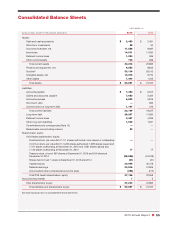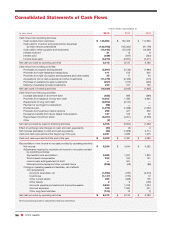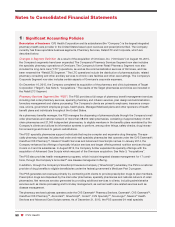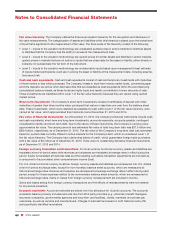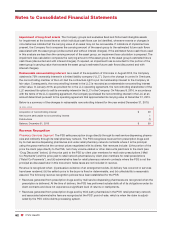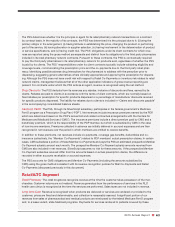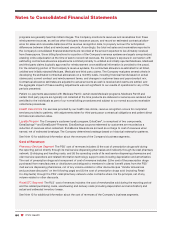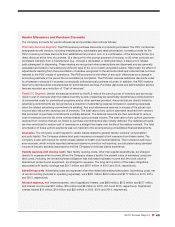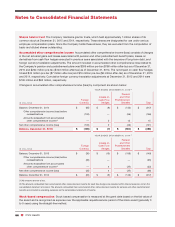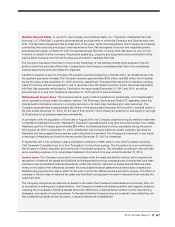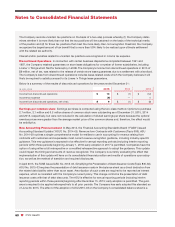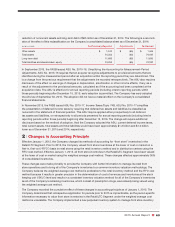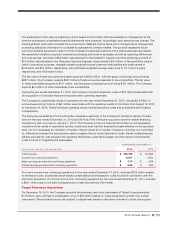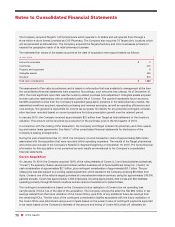CVS 2015 Annual Report Download - page 64
Download and view the complete annual report
Please find page 64 of the 2015 CVS annual report below. You can navigate through the pages in the report by either clicking on the pages listed below, or by using the keyword search tool below to find specific information within the annual report.
62 CVS Health
Notes to Consolidated Financial Statements
Impairment of long-lived assets The Company groups and evaluates fixed and finite-lived intangible assets
for impairment at the lowest level at which individual cash flows can be identified, whenever events or changes in
circumstances indicate that the carrying value of an asset may not be recoverable. If indicators of impairment are
present, the Company first compares the carrying amount of the asset group to the estimated future cash flows
associated with the asset group (undiscounted and without interest charges). If the estimated future cash flows used
in this analysis are less than the carrying amount of the asset group, an impairment loss calculation is prepared. The
impairment loss calculation compares the carrying amount of the asset group to the asset group’s estimated future
cash flows (discounted and with interest charges). If required, an impairment loss is recorded for the portion of the
asset group’s carrying value that exceeds the asset group’s estimated future cash flows (discounted and with
interest charges).
Redeemable noncontrolling interest As a result of the acquisition of Omnicare in August 2015, the Company
obtained a 73% ownership interest in a limited liability company (“LLC”). Due to the change in control in Omnicare,
the noncontrolling member of the LLC had the contractual right to put its membership interest to the Company at
fair value. Consequently, the noncontrolling interest in the LLC is recorded as a redeemable noncontrolling interest
at fair value. In January 2016, as provided for in the LLC operating agreement, the noncontrolling shareholder of the
LLC exercised its option to sell its ownership interest in the LLC to the Company. On February 8, 2016, in accordance
with the terms of the LLC operating agreement, the Company purchased the noncontrolling interest in the LLC at an
amount determined pursuant to the operating agreement that approximated its carrying value at December 31, 2015.
Below is a summary of the changes in redeemable noncontrolling interest for the year ended December 31, 2015:
IN MILLIONS
Acquisition of noncontrolling interest $ 39
Net income attributable to noncontrolling interest 1
Distributions (1)
Balance, December 31, 2015 $ 39
Revenue Recognition
Pharmacy Services Segment
The PSS sells prescription drugs directly through its mail service dispensing pharma-
cies and indirectly through its retail pharmacy network. The PSS recognizes revenue from prescription drugs sold
by its mail service dispensing pharmacies and under retail pharmacy network contracts where it is the principal
using the gross method at the contract prices negotiated with its clients. Net revenues include: (i) the portion of the
price the client pays directly to the PSS, net of any volume-related or other discounts paid back to the client (see
“Drug Discounts” below), (ii) the price paid to the PSS by client plan members for mail order prescriptions (“Mail
Co-Payments”) and the price paid to retail network pharmacies by client plan members for retail prescriptions
(“Retail Co-Payments”), and (iii) administrative fees for retail pharmacy network contracts where the PSS is not the
principal as discussed later in this document. Sales taxes are not included in revenue.
Revenue is recognized when: (i) persuasive evidence of an arrangement exists, (ii) delivery has occurred or services
have been rendered, (iii) the seller’s price to the buyer is fixed or determinable, and (iv) collectability is reasonably
assured. The following revenue recognition policies have been established for the PSS:
• Revenues generated from prescription drugs sold by mail service dispensing pharmacies are recognized when the
prescription is delivered. At the time of delivery, the PSS has performed substantially all of its obligations under its
client contracts and does not experience a significant level of returns or reshipments.
• Revenues generated from prescription drugs sold by third party pharmacies in the PSS’ retail pharmacy network
and associated administrative fees are recognized at the PSS’ point-of-sale, which is when the claim is adjudi-
cated by the PSS online claims processing system.





